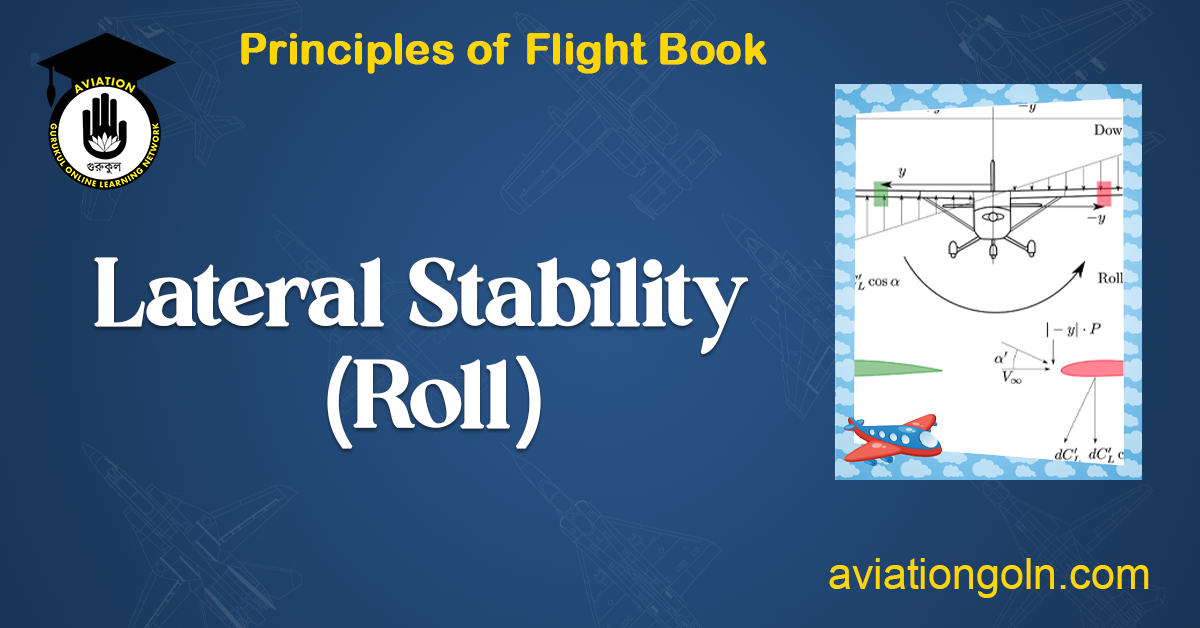Aircraft stability is an essential aspect of aeronautic design and pilot training, providing the foundation for safe and efficient flight. Of the various types of stability that need to be considered, lateral stability, or stability about an aircraft’s longitudinal axis (resulting in roll), is a critical component.
Lateral Stability (Roll)
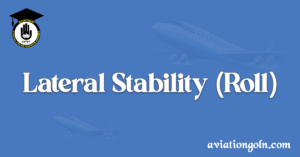
Understanding the Basics
Before delving deep into lateral stability, it’s crucial to understand the aircraft’s basic axes of rotation. Aircraft move about three principal axes:
Longitudinal Axis (Roll):
The longitudinal axis of an aircraft runs from the aircraft’s nose to its tail, essentially bisecting it lengthwise. When an aircraft rotates around this axis, the movement is termed “roll.” Ailerons, which are control surfaces located on the trailing edges of the wings, primarily facilitate this rolling motion. When a pilot wishes to bank or turn the aircraft, they manipulate the ailerons to induce a roll, tilting the wings in the desired direction. Proper control and stability around the longitudinal axis are vital for maneuvering, turning, and maintaining balanced flight, especially when responding to disturbances like crosswinds or turbulence.
Lateral Axis (Pitch):
The lateral axis of an aircraft runs from wingtip to wingtip, perpendicular to the aircraft’s line of flight. Movement about this axis is termed “pitch,” and it pertains to the nose of the aircraft moving up or down relative to the horizon. The control surfaces responsible for influencing pitch are the elevators, located on the trailing edge of the horizontal stabilizer.
Positive pitch denotes the nose rising, while negative pitch indicates the nose lowering. Pitch stability and control are crucial for various flight maneuvers, climbing, descending, and maintaining level flight. The ability of an aircraft to naturally return to a neutral pitch position after a disturbance, such as a gust of wind, is an essential factor in aircraft design and safety.
Vertical Axis (Yaw):
The vertical axis of an aircraft, commonly referred to as the yaw axis, runs vertically through the aircraft, perpendicular to the wings and the fuselage. When an aircraft experiences motion around this axis, it is termed as “yawing.” In simpler terms, yawing means the nose of the aircraft moves either to the left or right, deviating from its forward-facing direction.
The primary control surface responsible for managing yaw is the rudder, located on the vertical stabilizer at the tail of the aircraft. When a pilot provides input to the rudder pedals, the rudder deflects, creating a force that turns the aircraft’s nose left or right. Maintaining control around the yaw axis is crucial for coordinated flight, especially during turns, to prevent adverse flight conditions like skids or slips.
Lateral stability predominantly pertains to the roll movement around the longitudinal axis.
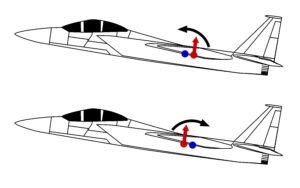
Lateral Stability Principles
Lateral stability ensures that an aircraft tends to return to its level flight position after being disturbed by rolling action. This stability is paramount, as without it, minor disturbances could escalate, leading to the plane entering a dangerous spiral.
Two primary forces impact lateral stability:
Dihedral Effect:
The dihedral angle is the upward angle of the airplane’s wings relative to a horizontal cross-section. When an aircraft rolls, the lowered wing experiences an increased angle of attack compared to the raised wing. As a result, the lowered wing generates more lift, causing the plane to roll back towards its original position.
Wing Sweep:
Aircraft with rearward-swept wings (like many modern jets) will notice that, during a side slip, the forward-facing wing has a higher angle of attack than the retreating wing. This difference also creates a self-righting roll moment.
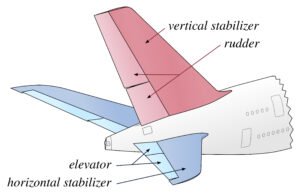
Factors Affecting Lateral Stability
Various design and operational factors can influence an aircraft’s lateral stability:
Wing Position:
Aircraft with high wings (above the fuselage) usually have greater lateral stability than low-wing aircraft. The weight of the fuselage hanging below the wings tends to restore the plane to its original position after a roll disturbance.
Weight Distribution:
Loads that are further outboard (further from the longitudinal axis) will increase the aircraft’s inertia in the roll direction, making it more resistant to roll changes but also slower to recover once rolled.
Aileron Design:
Ailerons control roll. The way they’re designed and implemented can also influence lateral stability. Differential ailerons, which move upward more than they move downward, can reduce adverse yaw and thus impact stability.
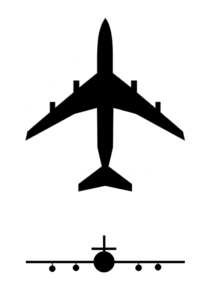
Lateral Control
When we speak of controlling an aircraft, the three primary axes of rotation come to mind: pitch, yaw, and roll. Lateral control pertains specifically to the roll axis. It’s about controlling the side-to-side tilt of an aircraft’s wings, which in turn affects the aircraft’s direction or path over the ground. This article will dive into the importance of lateral control, the primary components involved, and the principles behind its operation.
1. Why is Lateral Control Important?
Lateral control is crucial for several reasons:
- Maneuvering: To turn an aircraft, the wings must be tilted or “banked” in the direction of the desired turn. The degree of banking determines the rate and radius of the turn.
- Stability: Lateral control helps maintain level flight, ensuring that the aircraft doesn’t drift or roll unexpectedly due to disturbances like wind gusts or turbulence.
- Coordination: In conjunction with rudder control (yaw axis), lateral control ensures coordinated turns, preventing undesirable conditions such as slips or skids.
2. Primary Components for Lateral Control
The primary components responsible for providing lateral control in an aircraft are the ailerons and, in some designs, spoilers.
- Ailerons: These are hinged surfaces found on the trailing edges of the wings. When the pilot moves the control yoke or stick left or right, the ailerons move in opposite directions. If the left aileron moves up, the right one goes down and vice versa. An upward-deflected aileron reduces lift on that wing and causes it to drop, while a downward-deflected aileron increases lift and causes that wing to rise.
- Spoilers: These are surfaces that can be raised into the airflow over a wing to disrupt the smooth flow of air, reducing lift and increasing drag. On some aircraft, spoilers supplement or replace ailerons to assist with lateral control.
3. Principles of Operation
When a pilot wishes to roll the aircraft to the left:
- The left aileron is deflected upward, decreasing lift on the left wing.
- The right aileron is deflected downward, increasing lift on the right wing.
- The combined effect causes the aircraft to roll to the left.
For a right roll, the process is simply reversed.
In aircraft with spoilers for lateral control:
- To roll left, the right-wing spoiler is raised, disrupting the airflow and reducing lift on the right wing, causing the aircraft to roll to the left.
In coordinated turns, the rudder is also used in conjunction with lateral control inputs to ensure the nose of the aircraft points along the path of the turn, preventing the aircraft from slipping (nose points out of the turn) or skidding (nose points into the turn).
4. Differential Ailerons
To counteract the additional drag produced by the downward-deflected aileron (which can cause adverse yaw), some aircraft use differential ailerons. This means that the upward-moving aileron deflects more than the downward-moving one. This differential movement produces less drag on the rising wing, helping to counteract the yawing moment.
5. Flaperons
In some modern aircraft designs, the ailerons can also function as flaps, known as “flaperons.” This combined functionality allows these control surfaces to provide both lateral control and to change the wing’s camber for increased lift at slower speeds.
Lateral control is an essential aspect of aircraft operation, allowing for maneuverability, stability, and coordinated flight. Whether via traditional ailerons or modern adaptations like flaperons, the principle remains the same: control the roll of the aircraft to ensure a safe and efficient flight path. As aviation technology continues to evolve, the principles of lateral control remain foundational, ensuring pilots can safely and effectively navigate the skies.
Lateral control, primarily achieved through ailerons, is integral for a pilot to command the roll of an aircraft. When a pilot moves the control stick or yoke to the left, the left aileron moves up, and the right one moves down. This action increases the lift on the right wing and decreases lift on the left, causing the aircraft to roll to the left.

Coupling of Lateral and Directional Stability
The coupling of lateral and directional stability in aircraft dynamics is an intricate interplay that’s foundational to the flight characteristics of an airplane. When an aircraft experiences a roll, due to a gust of wind or other perturbations, this lateral motion often doesn’t occur in isolation.
Accompanying it is a yawing motion, a consequence of the aircraft’s design features and aerodynamic properties. This interrelation between roll and yaw can be visualized in scenarios where an airplane wing is raised: the raised wing experiences decreased lift but increased drag, especially if ailerons are deflected. This added drag on one side can cause the aircraft to yaw towards the raised wing, a phenomenon termed “adverse yaw.” For this reason, effective aircraft design and pilot training emphasize the importance of coordinating aileron (lateral control) and rudder (directional control) inputs.
The objective is to counteract these natural tendencies and maintain balanced flight. Furthermore, dihedral wing angles—where the wings are angled slightly upwards from root to tip—are employed in many aircraft designs to augment the inherent stability. With dihedral, a yawing motion will produce a rolling motion counter to the yaw, helping the aircraft naturally correct itself.
This coupling is also evident in the Dutch roll oscillation, a phenomenon where an aircraft alternately rolls and yaws due to these coupled dynamics. In essence, the intertwined nature of lateral and directional stability necessitates an integrated approach to both aircraft design and flight operation to ensure stability, control, and ultimately, safety in the skies.

Adverse Yaw
Adverse yaw is a common aerodynamic phenomenon experienced during the roll motion of an aircraft. As a pilot inputs a roll command—let’s say to the right—the right aileron moves up and the left aileron moves down. The down-going aileron (on the left wing in this case) generates increased lift but also increased drag, known as induced drag. Conversely, the up-going aileron on the right wing decreases both lift and drag. This differential in drag between the two wings causes the aircraft to yaw in the opposite direction of the roll, i.e., to the left when initiating a right roll, which is counterintuitive and undesired.
The presence of adverse yaw necessitates effective pilot training and coordination between the ailerons and the rudder. Pilots must be trained to apply appropriate rudder input to counteract the yawing motion, ensuring a smooth and coordinated turn. Without this corrective action, the aircraft could enter a slip, where it drifts sideways from its intended path of flight. As aviation technology has advanced, some modern aircraft incorporate design elements and automated systems to mitigate the effects of adverse yaw, making for more streamlined maneuvering. However, understanding and managing adverse yaw remains a foundational skill in pilot training and a critical component of aircraft control.

Technological Advancements
The realm of aeronautics has witnessed significant technological advancements over the years, especially in enhancing lateral stability (roll). Historically, aircraft relied primarily on the inherent design of wing dihedral and basic aileron systems to achieve and maintain lateral balance. However, with the advent of fly-by-wire systems, computer-controlled stabilization, and sophisticated winglet designs, modern aircraft can achieve far superior roll control and stability.
These advancements not only provide smoother flight experiences for passengers but also allow for more efficient and precise maneuvering by pilots, especially in challenging conditions. Furthermore, integrated sensor networks continuously monitor various flight parameters, enabling real-time adjustments to maintain optimal lateral stability. As a result, modern aviation has taken a significant leap towards safer and more efficient flight operations.

Lateral stability and control are paramount for the safety, performance, and efficiency of an aircraft. While the principles of lateral stability have remained consistent, the methods of achieving and controlling that stability have evolved with technological advancements. A keen understanding of these principles is essential for aircraft designers, pilots, and aviation professionals.
Note: This article provides a basic understanding of the principles of lateral stability and control. In practice, the study of lateral stability involves complex mathematical models, wind tunnel tests, and flight tests to ensure an aircraft’s safety and performance.
See more:
